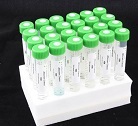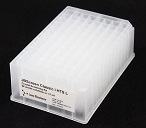JBScreen JCSG ++
JBScreen JCSG++ is a sparse matrix screen optimized for initial screening of crystallization conditions of biological macromolecules. The screen has been formulated by researchers from the Joint Center for Structural Genomics (JCSG) [1] and from the European Genomics Consortium [2].
Full DescriptionProduct Information
96 reagents have been selected with the aim to maximize the coverage of the crystallization parameter space and to reduce the redundancy of crystallization conditions within commercially available crystallization screens. Thus, a core set of 66 conditions used by the JCSG for high-throughput structural determination [1] was extended to 96 screening conditions in order to round off the pH profile and to incorporate different precipitants such as succinate, malonate and formate.
When JBScreen JCSG++ is used along with JBScreen PACT++, the benefits of a sparse matrix screen can be combined with the systematic investigation the precipitation behaviour of the protein.
Format
Bulk – 24 or 96 screening solutions in 10 ml aliquots
HTS – 96 screening solutions delivered in a deep-well block, 1.7 ml per well
References
[1] Page et al. (2004) Shotgun crystallization strategy for structural genomics: an optimized two-tiered crystallization screen against the Thermotoga maritima proteome. Acta Cryst. D 59:1028.[2] Newman et al. (2005) Towards rationalization of crystallization screening for small- to medium-sized academic laboratories: the PACT/JCSG+ strategy. Acta Cryst. D 61:1426.
Selected Literature Citations of JBScreen JCSG++
Kumar et al. (2017) Non-classical transpeptidases yield insight into new antibacterials. Nat. Chem. Biol. 13:54.
Cattani et al. (2015) Structure of a PEGylated protein reveals a highly porous double-helical assembly. Nat. Chem. 7:823.
Boltsis et al. (2014) Non-contact Current Transfer Induces the Formation and Improves the X‑ray Diffraction Quality of Protein Crystals. Crystal Growth & Design 14:4347.


